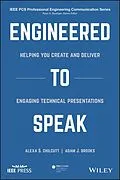Engineered to Speak: Helping You Create and Deliver Engaging Technical Presentations Technical expertise alone is not enough to ensure professional success. Twenty-first century engineers and technical professionals must master making the complex simple and the simple interesting. This book helps engineers do what they love most: take a complicated system and create a stronger solution. You will learn tips and strategies that help you answer one essential question, "How can I get better at sharing my ideas with a variety of audiences?" In Engineered to Speak, Alexa Chilcutt and Adam Brooks combine their expertise in messaging and public speaking with research that illustrates how effective communication contributes to career advancement. Each chapter contains inspiring stories from practicing engineers around the world as well as useful examples, exercises and repeatable processes for creating compelling messages. This book helps technical talent become better speakers, better communicators, and ultimately better leaders. This helpful guide demystifies the art of oral communication by breaking it down into ten easy-to-follow-processes that can improve the ability of professionals at any level. By the end of Engineered to Speak, you'll understand how to gain buy-in, identify and expand your Sphere of Influence, amplify your message, deliver compelling presentations, and learn from those who've embrace these skills and enjoyed professional success.
Klappentext
ENGINEERED TO SPEAK: HELPING YOU CREATE AND DELIVER ENGAGING TECHNICAL PRESENTATIONS
Technical expertise alone is not enough to ensure professional success. Twenty-first century engineers and technical professionals must master making the complex simple and the simple interesting. This book helps engineers do what they love most: take a complicated system and create a stronger solution. You will learn tips and strategies that help you answer one essential question, "How can I get better at sharing my ideas with a variety of audiences?"
In??Engineered to Speak, Alexa S. Chilcutt and Adam J. Brooks combine their expertise in messaging and public speaking with research that illustrates how effective communication contributes to career advancement. Each chapter contains inspiring stories from practicing engineers around the world as well as useful examples, exercises, and repeatable processes for creating compelling messages.
This book helps technical talent become better speakers, better communicators, and ultimately better leaders. This helpful guide demystifies the art of oral communication by breaking it down into ten easy-to-follow processes that can improve the ability of professionals at any level. By the end of??Engineered to Speak, you'll understand how to gain buy-in, identify, and expand your Sphere of Influence, amplify your message, deliver compelling presentations, and learn from those who've embrace these skills and enjoyed professional success.
Inhalt
A Note From Series Editor xi
About the Authors xiii
Acknowledgments xv
PART I: RECOGNIZE COMMUNICATION OPPORTUNITIES
1 WHY THIS BOOK? 3
1.1 Why Now? 5
1.2 Managers 6
1.3 Engineers and Technical Professionals 6
1.4 Students 7
1.5 Embracing Your Power as a Presenter 7
1.6 How to Use this Book 8
1.7 Calls to Action 9
2 DEMYSTIFYING COMMUNICATION AND ENGINEERING 11
2.1 The Place to Start 12
2.2 Rejecting Stereotypes 13
2.3 Debunking the Myths 14
2.3.1 Myth 1: Good Communicators Are Not Anxious 14
2.3.2 Myth 2: Some People Are Naturally Great Speakers 15
2.3.3 Myth 3: Winging it Works 16
2.3.4 Myth 4: Need to Be the "Sage on Stage" 16
2.3.5 Myth 5: Data Is Supreme 17
2.3.6 Myth 6: Time - I Must Fill It 17
2.3.7 Myth 7: Extroverts Make Better Speakers 18
2.4 Calls to Action 18
2.4.1 Communication Assessment Questions 18
2.4.2 Level of Anxiety in Public Speaking Situations 19
2.4.3 Putting Knowledge into Practice 20
3 RECOGNIZING COMMUNICATION OPPORTUNITIES 23
3.1 The Sphere of Influence Model 24
3.1.1 Internal Interactions Quadrant 25
3.1.2 Leadership Interactions Quadrant 26
3.1.3 External Interactions Quadrant 27
3.1.4 Personal Interactions Quadrant 28
3.2 Communicating to Connect 28
3.3 Listening Hang9;]Ups 29
3.4 Active Listening Tactics 31
3.4.1 Paraphrasing 31
3.4.2 Priming 31
3.4.3 Expressing Understanding 31
3.4.4 Use of Nonverbal Body Language 32
3.5 Putting it into Practice 32
3.6 Calls to Action 34
4 ASKING THE QUESTIONS 37
4.1 Asking the Questions 38
4.1.1 Who Am I Speaking to? 39
4.1.2 What Is the Purpose of My Presentation? 39
4.1.3 What Is the Desired Outcome? 39
4.1.4 What Information Matters Most? 40
4.1.5 Why Should they Care? 40
4.1.6 When Am I Speaking? 41
4.1.7 Where Am I Speaking? 41
4.1.8 How Should I Present? 41
4.2 Analyzing your Audience 42
4.2.1 Captive Verses Voluntary Audiences 42
4.2.2 Knowledge 43
4.2.3 Technical and Nontechnical Audiences 43
4.2.4 The Jargon Barrier 44
4.3 Competing for Attention 45
4.4 Opposing Viewpoints 46
4.5 Calls to Action 47
PART II: APPLY THE PROCESS
5 ORGANIZING AND OUTLINING YOUR PRESENTATION 51
5.1 Benefits of Organization Decreasing Uncertainty 52
5.2 Engineering the Outline 52
5.2.1 Informational Organizational Pattern 53
5.2.2 Put it into Practice 54
5.2.3 Persuasive Organizational Patterns 56
5.2.4 Transitions 57
5.3 How to Begin your Presentation 57
5.4 How to Close your Presentation 59
5.5 Preparation Outline 60
5.6 Calls to Action 60
6 PERFECTING YOUR PITCH 63
6.1 Lead with Meaning 64
6.2 Start with an Essential Truth 64
6.3 Use Evidence to Tell your Story 65
6.3.1 Building Compelling Narratives 66
6.3.2 Applying the STAR Method 66
6.4 End with the Call to Action 68
6.5 Calls to Action 69
7 VISUALIZING YOUR MESSAGE 71
7.1 Understanding why Visuals Work 73
7.2 Designing your Slides 75
7.2.1 Storyboard Design 76
7.2.2 Keep it Simple 77
7.3 Handling Handouts 79
7.4 Physical Objects/Demonstrations 81
7.5 Real9;]time Writing and Drawing 82
7.5.1 The White Board 82
7.5.2 The Flip Chart 83
7.6 Calls to Action 85
8 CREATING CHARISMA 87
8.1 Dynamic Delivery 88
8.2 The Voice 88
8.2.1 Tone 89
8.2.2 Volume 90
8.2.3 Rate 91
8.2.4 Pausing 9...
